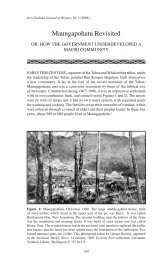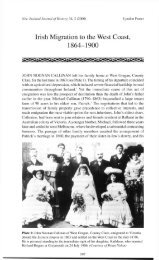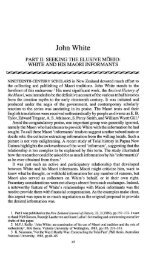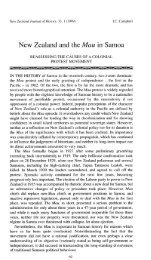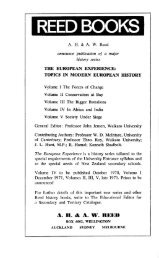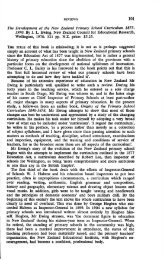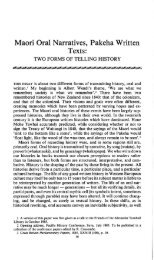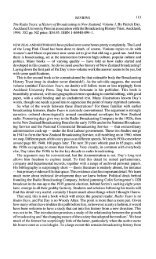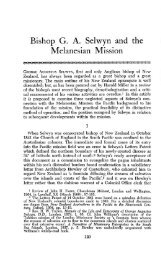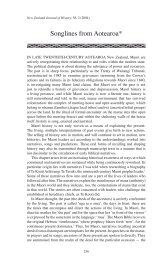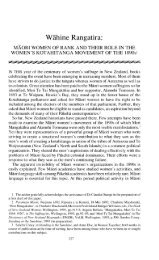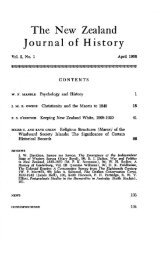Friendly Societies 1842-1938 - New Zealand Journal of History ...
Friendly Societies 1842-1938 - New Zealand Journal of History ...
Friendly Societies 1842-1938 - New Zealand Journal of History ...
Create successful ePaper yourself
Turn your PDF publications into a flip-book with our unique Google optimized e-Paper software.
122 JENNIFER CARL YON<br />
Tennant's Paupers and Providers: Charitable Aid in <strong>New</strong> <strong>Zealand</strong>, is one such<br />
investigation. 6 Although a study <strong>of</strong> statutory welfare arrangements, it looks<br />
beyond the intent <strong>of</strong> the legislation to assess the implementation <strong>of</strong> charitable aid<br />
and its impact on beneficiaries. A more general investigation into the ways in<br />
which the <strong>New</strong> <strong>Zealand</strong> people sought to protect themselves against need in old<br />
age in the nineteenth and early twentieth centuries has been undertaken by David<br />
Thomson in A World Without Welfare, <strong>New</strong> <strong>Zealand</strong>'s Colonial Experiment?<br />
Before this last decade, friendly societies had been generally either ignored by<br />
historians or, with one exception, dismissed as insignificant because <strong>of</strong> the<br />
limitations placed on membership — specifically that only those in good health<br />
who could maintain the regular contributions could afford to be members. 8<br />
Typical <strong>of</strong> the latter approach is Heather Shepherd who, in her 1976 research<br />
exercise on friendly societies in late nineteenth-century <strong>New</strong> <strong>Zealand</strong>, describes<br />
them as having little impact on <strong>New</strong> <strong>Zealand</strong> society. 9 She argues that by the end<br />
<strong>of</strong> the first decade <strong>of</strong> the twentieth century the movement had begun to falter. Yet<br />
it was in fact during the first three decades <strong>of</strong> the twentieth century that friendly<br />
societies experienced their greatest expansion and that financial stability was<br />
finally achieved. <strong>New</strong> benefit funds were set up to enable their members to have<br />
access to the increasingly sophisticated medical technology being used in<br />
hospitals, and United <strong>Friendly</strong> Society (UFS) pharmacies were set up throughout<br />
the country. Membership had risen from 41,236 members in 1901 to 113,709 by<br />
<strong>1938</strong>. Although this figure represented only 11% <strong>of</strong> the adult population,<br />
friendly society benefits were extended to spouses and children, which meant<br />
that by this date approximately 20% <strong>of</strong> the total population benefited from these<br />
mutual aid societies.<br />
More recently this negative assessment <strong>of</strong> friendly societies has been restated<br />
by David Thomson. In an article investigating thrift in nineteenth-century <strong>New</strong><br />
<strong>Zealand</strong> he concludes that friendly societies were 'weak and irrelevant' and<br />
unable to deliver what they promised due to financial insolvency. 10 He argues<br />
that they were financially unsound, that 'they never had the resources to match<br />
their promises'; this was, in his view, 'the "dark secret" <strong>of</strong> friendly societies<br />
everywhere'. He goes on to contend that the friendly societies themselves<br />
persisted in ignoring the evidence and continued to 'promise high and charge low'.<br />
While this assertion is true for the nineteenth century it was manifestly<br />
6 Wellington, 1989.<br />
7 Auckland, 1998.<br />
8 An exception is J.K. Hoar, 'A Descriptive <strong>History</strong> <strong>of</strong> the Major Aspects <strong>of</strong> the <strong>Friendly</strong> Society<br />
Movement in <strong>New</strong> <strong>Zealand</strong> 1840-1900', MA thesis, The University <strong>of</strong> Idaho Graduate School, 1963,<br />
which shows that they were an important part <strong>of</strong> the 'common man's' life, providing a source <strong>of</strong><br />
insurance against unexpected adversities as well as a focal point for social and recreational activities.<br />
9 Heather Shepherd, 'The Nature and Role <strong>of</strong> <strong>Friendly</strong> <strong>Societies</strong> in Later Nineteenth Century <strong>New</strong><br />
<strong>Zealand</strong>', BA (Hons) Research Exercise, Massey University, 1976.<br />
10 David Thomson, 'Colonial Thrift', <strong>History</strong> Now, 3,1 (1997), pp.8-13.



